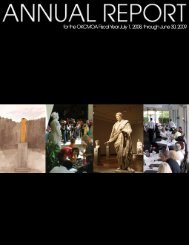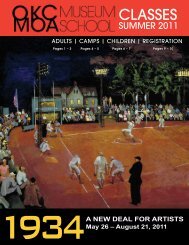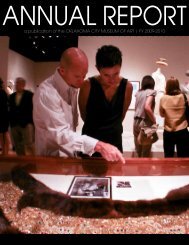Roman Art from the Louvre Educators' Resource Guide
Roman Art from the Louvre Educators' Resource Guide
Roman Art from the Louvre Educators' Resource Guide
You also want an ePaper? Increase the reach of your titles
YUMPU automatically turns print PDFs into web optimized ePapers that Google loves.
8<br />
third century, emperors resolved to share command, an idea that led to <strong>the</strong><br />
division of <strong>the</strong> empire into east and west sections by Emperor Diocletian,<br />
who established <strong>the</strong> short-lived Tetrarchy in 293 A.D., which split imperial<br />
authority among four leaders.<br />
The senate was a respected council of elders that lacked lawmaking abilities<br />
but served as an advisory body to <strong>the</strong> emperor. One of its chief functions<br />
was bestowing <strong>the</strong> title of emperor, and that alone made <strong>the</strong> senate important.<br />
Only wealthy, male <strong>Roman</strong> citizens could be appointed to <strong>the</strong> senate,<br />
and once in office, a motivated senator could advance politically. The senate<br />
had significant judicial functions and could appoint officials to such tasks as<br />
managing public lands, appropriating funds, and conducting wars. Senators<br />
enjoyed elite social status and were accorded privileges such as preferential<br />
seating at public ceremonies and entertainment events.<br />
Citizenship<br />
The <strong>Roman</strong> Empire embraced <strong>the</strong> concept of civitas, or citizenship, which<br />
was inherited <strong>from</strong> <strong>the</strong> republic. All of <strong>Roman</strong> society was based on <strong>the</strong><br />
division between citizens and non-citizens, with non-citizens defined<br />
solely by <strong>the</strong>ir relationships with <strong>the</strong> citizens.<br />
Originally, a <strong>Roman</strong> citizen was a man who was recorded in <strong>the</strong> registry<br />
of <strong>the</strong> thirty-five tribes of <strong>the</strong> city of Rome and in <strong>the</strong> census that was<br />
conducted every five years. This initial, narrowly defined concept of citizenship<br />
soon evolved toward a more judicial, abstract idea whereby citizenship<br />
was thought of as a body of rights and obligations that applied<br />
even to independent peoples who were at a considerable distance <strong>from</strong><br />
<strong>the</strong> center of power. <strong>Roman</strong> citizenship became widely available and could<br />
be acquired through numerous avenues. If a man was not born a citizen,<br />
he could become one by holding office as a local magistrate, being emancipated<br />
as a former slave, serving in <strong>the</strong> army, or immigrating. Ultimately,<br />
citizenship collectively granted to groups of people or to entire territories<br />
became <strong>the</strong> most significant agent for <strong>the</strong> spreading of citizenship. The first<br />
steps in increasing <strong>the</strong> rights of citizenship were taken during <strong>the</strong> reign of<br />
Augustus, and <strong>the</strong>y culminated with <strong>the</strong> Antonine Constitution in 212 A.D.,<br />
when Caracalla granted citizenship to every free man in <strong>the</strong> empire.<br />
The concept of citizenship, with all its legal, social, and political ramifications,<br />
was most fully expressed in monumental public settings, foremost among<br />
which was <strong>the</strong> forum. Initially designed to serve as a marketplace, it quickly<br />
grew into a public space for both public and private business. Around <strong>the</strong><br />
forum were <strong>the</strong> city’s most important buildings, including basilicas—closed
















